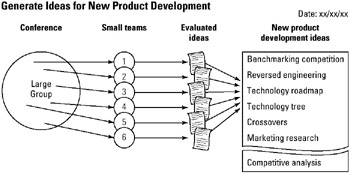Tool 131: Phillips 66
| AKA | Phillips 66 Buzz Session |
| Classification | Idea Generating (IG) |
Tool description
The Phillips 66 method was originated by Donald Phillips of Hillsdale College for the purpose of getting more involvement—questions, ideas, or opinions—from a large conference group. In order to effectively do this, the audience (large group) is divided into small groups of six people each and after some discussion, these groups present their results to the conference panel or leader.
Typical application
-
To start a problem-solving effort by involving a great number of people to discuss the issues involved and present potential solutions.
-
To generate a large number of ideas from a large group or audience.
-
To collect and evaluate several sets of ideas generated by a few loosely assembled small groups.
Problem-solving phase
| → | Select and define problem or opportunity |
| → | Identify and analyze causes or potential change |
| → | Develop and plan possible solutions or change |
| Implement and evaluate solution or change | |
| Measure and report solution or change results | |
| Recognize and reward team efforts |
Typically used by
| Research/statistics | |
| 1 | Creativity/innovation |
| 4 | Engineering |
| Project management | |
| Manufacturing | |
| 3 | Marketing/sales |
| Administration/documentation | |
| Servicing/support | |
| Customer/quality metrics | |
| 2 | Change management |
before
-
Data Collection Strategy
-
Audience Analysis
-
Interview Technique
-
Presentation
-
Nominal Group Technique (NGT)
after
-
Consensus Decision Making
-
Idea Advocate
-
Creativity Assessment
-
Gap Analysis
-
Importance Weighting
Notes and key points
-
The original Phillips 66 process called for the dividing of a large group into smaller groups of 6 people each and to allow 6 minutes per small group for discussing a problem or generating ideas.
-
The small group size (5-10) should be adjusted in accordance with the size (25–100) of the large groups. Also, small group discussion time may need to be increased up to 30 minutes.
Step-by-step procedure
-
STEP 1 A large group of 25–100 people is subdivided into small teams of 5-10 people each. If possible, teams move to a different location so that they will not be overheard by other teams.
-
STEP 2 The team selects a spokesperson who will record and present the team's ideas.
-
STEP 3 Next, a well-defined problem or an issue is presented for discussion. After a 6-30 minute discussion, ideas are recorded. See example Generate Ideas for New Product Development.
-
STEP 4 Each team evaluates their ideas, reduces the many to a few promising ideas, and presents them to the conference facilitator or panel.
-
STEP 5 All teams return to their seats and the facilitator or panel receives the recorded ideas from each team.
-
STEP 6 The entire set of ideas is either saved for later evaluation or is displayed to the audience and dicussed on the spot.
Example of tool application

EAN: 2147483647
Pages: 326